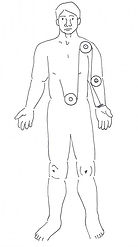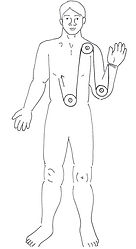
The Myofascial System
Performance and function of all body systems and movements, including the relationship between the connective tissue and muscle, depends on the balance within the myofascial system. It is the most pervasive system in our bodies, connecting every cell to every other cell. It is composed of collagen and elastin fibers that provide flexibility (elastin) and support for the entire musculoskeletal system, connects all structures to other structures, forms a protective conduit to keep external pressure off the neurovascular system, and holds memory. The muscle and tissue of the myofascial system work like a fulcrum and lever. (Diagram) The force vectors of the fascia tissue act like a pulley system. Muscles act to move the joints within these pulley systems. The joint is the fulcrum and the fascia is the rope. The muscles provide the force on the rope. Basic laws of physics state that in a pulley system, a small amount of force at a distant point can be translated through a system of levers to move a large amount of resisitance. So if the hands are considered to be the distal point, the cervical spine, shoulders and elbows provide a series of fulcrums to provide energy (force or power to the hands). In order to do hand work, energy from the shoulders is required. The translation of force through the pulley system is optimal when you are balanced, and when tension is released. Imbalance creates restrictions in the myofascial system, which may result in repetitive stress injury, recorded in the fascia memory as Cumulative Trauma Dysfunction.

Physiology
It is important to have an understanding of the Myofascial Sytem of the body, in order to realize the significance and full capabilities of the CTExerciser. The CTExerciser is a mobility tool, designed to treat the cause, not the symptoms. Learn about what causes Carpal Tunnel Syndrome, and other Cumulative Trauma Disorders, and what you can do about it.
Cumulative Trauma Dysfunction (CTD)
Cumulative Trauma Disorders are caused by many types of stresses, incidents, personal health and social factors accumulating daily over a period of time. Job design, work habits, and personal circumstances act together to perpetuate the risk of developing Cumulative Trauma Dysfunction. Any type of stress, whether it is physical, mental, or emotional, causes tension in our bodies that accumulates due to static sustained posture. Tension manifests, in a physical manner, in the myofascial system. Tension can traumatize the body if it is not released. It results in loss of flexibility, impaired posture, inefficient movement, decreased range of motion, and decreased strength and grasp indicating an imbalance in muscle groups. Other symptoms such as numbness, pain, burning, and swelling, are signals of vascular impairment. These symptoms can eventually cause permanent damage if they go unresolved. Though CTD is usually recognized by dysfunction in the hand, this disorder actually begins at the upper-back. The goal of the CTExerciser is to restore the body’s inherent equilibrium by removing restrictions and tensions that accumulate in the fascia tissue.
Carpal Tunnel Syndrome (CTS)
Carpal Tunnel Syndrome (CTS) is the compression of the median nerve in the carpal tunnel at the wrist, which can lead to severe dysfunction, and in many cases permanent disability.
The carpal tunnel is a structure in the wrist that is formed by the transverse ligament and carpal bones. (Diagram) The carpal tunnel protects the median nerve, tendons, and blood vessels as they extend through the wrist. The median nerve is responsible for sensing touch, position, coordination, and strength in the thumb and first two fingers.
In the majority of cases, stress in the head, neck, and shoulders causes a tightening of connective tissue (fascia) which shortens and pulls up from the hands and wrist, causing pressure on the nerves and blood vessels. This can then create compression of the median nerve, as well as other nerves. It is the tension in the neck and upper arm that causes distress on the wrist which causes the symptoms of CTS. You have to treat from the neck (the source) down, not the symptoms, which is exactly what the CTExerciser does.




